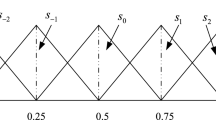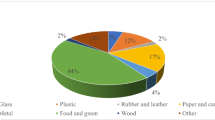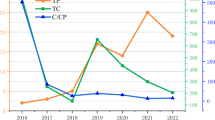Abstract
The prosperity of online mobile phone recycling platforms has brought convenience to waste mobile phone recycling. This study aims to propose a novel decision-making method to evaluate the recycling channels of mobile phones in an uncertain environment using the probabilistic linguistic term set (PLTS) to represent uncertain information. Given that each PLTS is associated with a probability distribution, the differences of different PLTSs can be represented by comparing different probability distributions. The Hellinger distance is a widely-used index to measure the similarity of two probability distributions, but it cannot be directly used to express the semantic differences of PLTSs. In this regard, we introduce a cumulative probability-based Hellinger distance measure of PLTSs. Then, we propose an extension of TODIM (an acronym in Portuguese of Interactive and Multicriteria Decision Making) method considering the bounded rationality and psychology of decision-makers based on the proposed distance measure of PLTSs and a criterion weight determination method, the Simos-Roy-Figueira method. Finally, an illustrative example of evaluating the recycling channels of mobile phones is given with sensitive and comparative analyses, showing the efficiency of the proposed method. This method can also be applied to other various fields.










Similar content being viewed by others
References
Belton V, Stewart T (2002) Multiple criteria decision analysis: an integrated approach. Kluwer Academic Publishers, Dordrecht
Beran R (1977) Minimum Hellinger distance estimates for parametric models. Ann Stat 5(3):445–463. https://doi.org/10.1214/aos/1176343842
Cinelli M, Kadziński M, Gonzalez M, Słowiński R (2020) How to support the application of multiple criteria decision analysis? Let us start with a comprehensive taxonomy. Omega 102261:102261. https://doi.org/10.1016/j.omega.2020.102261
Corrente S, Figueira JR, Greco S, Słowiński R (2017) A robust ranking method extending ELECTRE III to hierarchy of interacting criteria, imprecise weights and stochastic analysis. Omega 73:1–17. https://doi.org/10.1016/j.omega.2016.11.008
Figueira J, Roy B (2002) Determining the weights of criteria in the ELECTRE type methods with a revised Simos’ procedure. Eur J Oper Res 139:317–326. https://doi.org/10.1016/S0377-2217(01)00370-8
Figueira J, Greco S, Ehrgott M (2005) Multiple criteria decision analysis. Springer, State of the art surveys
Gomes LFAM, Lima MMPP (1991) TODIM: basic and application to multicriteria ranking of projects with environmental impacts. Found Comput Decis Sci 16(3):113–127
Gu F, Summers PA, Hall P (2019) Recovering materials from WMPs: recent technological developments. J Clean Prod 237:117657. https://doi.org/10.1016/j.jclepro.2019.117657
Guo X, Yan K (2017) Estimation of obsolete cellular phones generation: a case study of China. Sci Total Environ 575:321–329. https://doi.org/10.1016/j.scitotenv.2016.10.054
Huang J, Liu HC, Duan CY, Song MS (2019) An improved reliability model for FMEA using probabilistic linguistic term sets and TODIM method. Ann Oper Res:1–24. https://doi.org/10.1007/s10479-019-03447-0
Jiang LS, Liao HC (2020) Network consensus analysis of probabilistic linguistic preference relations for group decision making and its application in urban household waste classification. J Clean Prod 278:122766. https://doi.org/10.1016/j.jclepro.2020.122766
Kahneman D, Tversky A (1979) Prospect theory: an analysis of decision under risk. Econometrica 47:263–291. https://doi.org/10.1142/9789814417358_0006
Kodikara PN, Perera BJC, Kularathna MDUP (2010) Stakeholder preference elicitation and modelling in multi-criteria decision analysis–a case study on urban water supply. Eur J Oper Res 206(1):209–220. https://doi.org/10.1016/j.ejor.2010.02.016
Liao HC, Wu XL, Liang XD, Yang JB, Xu DL, Herrera F (2018) A continuous interval-valued linguistic ORESTE method for multi-criteria group decision making. Knowl-Based Syst 153:65–77. https://doi.org/10.1016/j.knosys.2018.04.022
Liao HC, Mi XM, Xu ZS (2020) A survey of decision-making methods with probabilistic linguistic information: Bibliometrics, preliminaries, methodologies, applications and future directions. Fuzzy Optim Decis Ma 19(1):81–134. https://doi.org/10.1007/s10700-019-09309-5
Liu P, Teng F (2019) Probabilistic linguistic TODIM method for selecting products through online product reviews. Inf Sci 485:441–455. https://doi.org/10.1016/j.ins.2019.02.022
Liu Y, Fan ZP, Zhang Y (2011) A method for stochastic multiple criteria decision making based on dominance degrees. Inf Sci 181(19):4139–4153. https://doi.org/10.1016/j.ins.2011.05.013
Liu J, Bai H, Zhang Q, Jing Q, Xu H (2019) Why are obsolete mobile phones difficult to recycle in China? Resour Conserv Recycl 141:200–210. https://doi.org/10.1016/j.resconrec.2018.10.030
Llamazares B (2018) An analysis of the generalized TODIM method. Eur J Oper Res 269(3):1041–1049. https://doi.org/10.1016/j.ejor.2018.02.054
Lourenzutti R, Krohling RA (2014) The Hellinger distance in multicriteria decision making: an illustration to the TOPSIS and TODIM methods. Expert Syst Appl 41(9):4414–4421. https://doi.org/10.1016/j.eswa.2014.01.015
Pang Q, Wang H, Xu ZS (2016) Probabilistic linguistic term sets in multi-attribute group decision making. Inf Sci 369:128–143. https://doi.org/10.1016/j.ins.2016.06.021
Peng HG, Wang JQ, Zhang HY (2020) Multi-criteria outranking method based on probability distribution with probabilistic linguistic information. Comput Ind Eng 141:106318. https://doi.org/10.1016/j.cie.2020.106318
Pereira MA, Figueira JR, Marques RC (2020) Using a Choquet integral-based approach for incorporating decision-maker’s preference judgments in a data envelopment analysis model. Eur J Oper Res 284:1016–1030. https://doi.org/10.1016/j.ejor.2020.01.037
Ren PJ, Xu ZS, Gou XJ (2016) Pythagorean fuzzy TODIM approach to multi-criteria decision making. Appl Soft Comput 42:246–259. https://doi.org/10.1016/j.asoc.2015.12.020
Rodriguez RM, Martínez L, Herrera F (2012) Hesitant fuzzy linguistic term sets for decision making. IEEE Trans Fuzzy Syst 20(1):109–119. https://doi.org/10.1109/TFUZZ.2011.2170076
Singh N, Duan H, Tang Y (2020) Toxicity evaluation of E-waste plastics and potential repercussions for human health. Environ Int 137:105559. https://doi.org/10.1016/j.envint.2020.105559
Sun Q, Wang C, Zhou Y, Zuo L, Tang J (2020) Dominant platform capability, symbiotic strategy and the construction of “internet+ WEEE collection” business ecosystem: a comparative study of two typical cases in China. J Clean Prod 254:120074. https://doi.org/10.1016/j.jclepro.2020.120074
Tversky A, Kahneman D (1992) Advances in prospect theory: cumulative representation of uncertainty. Risk Uncertain 5:297–323. https://doi.org/10.1007/BF00122574
Wang HD, Han HG, Liu TT, Tian X, Xu M, Wu YF, Gu YF, Liu YR, Zuo TY (2018) “Internet+” recyclable resources: a new recycling mode in China. Resour Conserv Recycl 134:44–47. https://doi.org/10.1016/j.resconrec.2018.03.006
Wang X, Wang J, Zhang H (2019) Distance-based multicriteria group decision-making approach with probabilistic linguistic term sets. Expert Syst 36(2):e12352. https://doi.org/10.1111/exsy.12352
Wu XL, Liao HC (2019) A consensus-based probabilistic linguistic gained and lost dominance score method. Eur J Oper Res 272(3):1017–1027. https://doi.org/10.1016/j.ejor.2018.07.044
Zadeh LA (1975) The concept of a linguistic variable and its applications to approximate reasoning-part II. Inf Sci 8:199–249. https://doi.org/10.1016/0020-0255(75)90046-8
Zhang XL, Xu ZS (2014) The TODIM analysis approach based on novel measured functions under hesitant fuzzy environment. Knowl-Based Syst 61:48–58. https://doi.org/10.1016/j.knosys.2014.02.006
Acknowledgements
The work was supported by the National Natural Science Foundation of China (Nos. 71771156, 71971145).
Author information
Authors and Affiliations
Corresponding author
Additional information
Publisher’s note
Springer Nature remains neutral with regard to jurisdictional claims in published maps and institutional affiliations.
Appendix
Appendix
1.1 The Proof of Theorem 1
Proof: (1) \( CHd\left({l}_2,{l}_1\right)=\sqrt{\sum \limits_{t=-\tau}^{\tau }{\left(\sqrt{f_t^{(2)}}-\sqrt{f_t^{(1)}}\right)}^2}=\sqrt{\sum \limits_{t=-\tau}^{\tau }{\left(\sqrt{f_t^{(1)}}-\sqrt{f_t^{(2)}}\right)}^2}= CHd\left({l}_1,{l}_2\right) \).
(2) \( CHd\left({l}_1,{l}_1\right)=\sqrt{\sum \limits_{t=-\tau}^{\tau }{\left(\sqrt{f_t^{(1)}}-\sqrt{f_t^{(1)}}\right)}^2}=0 \).
(3) Let \( CHd\left({l}_1,{l}_2\right)=\sqrt{\sum \limits_{t=-\tau}^{\tau }{\left(\sqrt{f_t^{(1)}}-\sqrt{f_t^{(2)}}\right)}^2} \), \( CHd\left({l}_2,{l}_3\right)=\sqrt{\sum \limits_{t=-\tau}^{\tau }{\left(\sqrt{f_t^{(2)}}-\sqrt{f_t^{(3)}}\right)}^2} \), and \( CHd\left({l}_1,{l}_3\right)=\sqrt{\sum \limits_{t=-\tau}^{\tau }{\left(\sqrt{f_t^{(1)}}-\sqrt{f_t^{(3)}}\right)}^2} \). Because CHd(l1, l2) ≥ 0, CHd(l1, l3) + CHd(l3, l2) ≥ CHd(l1, l2)⇔ (CHd(l1, l3) + CHd(l3, l2))2 ≥ CHd2(l1, l2). That is
Thus, we need to prove
If Inequality (14) is held, Inequality (13) is necessary to be held. Inequality (14) can be simplified as:
According to the information entropy inequality\( \sum \limits_{t=-\tau}^{\tau }{w}_i\ln {w}_i\ge \sum \limits_{t=-\tau}^{\tau }{w}_i\ln {p}_i\ln \left(\frac{e^{\sqrt{f_t^{(2)}}}}{e^{\sqrt{f_t^{(3)}}}}\right) \), we can obtain that \( \sum \limits_{t=-\tau}^{\tau }{e}^{\sqrt{f_t^{(1)}}}\ln \left(\frac{e^{\sqrt{f_t^{(3)}}}}{e^{\sqrt{f_t^{(1)}}}}\right)\ge 0 \), \( \sum \limits_{t=-\tau}^{\tau }{e}^{\sqrt{f_t^{(3)}}}\ln \left(\frac{e^{\sqrt{f_t^{(3)}}}}{e^{\sqrt{f_t^{(2)}}}}\right)\ge 0 \). Because \( {e}^{\sqrt{f_t^{(1)}}} \), \( \sum \limits_{t=-\tau}^{\tau}\ln \left(\frac{e^{\sqrt{f_t^{(3)}}}}{e^{\sqrt{f_t^{(1)}}}}\right)\ge 0 \), \( \sum \limits_{t=-\tau}^{\tau}\ln \left(\frac{e^{\sqrt{f_t^{(3)}}}}{e^{\sqrt{f_t^{(2)}}}}\right)\ge 0 \), it follows \( \sum \limits_{t=-\tau}^{\tau}\ln \left(\left(\frac{e^{\sqrt{f_t^{(3)}}}}{e^{\sqrt{f_t^{(1)}}}}\right)+\left(\frac{e^{\sqrt{f_t^{(3)}}}}{e^{\sqrt{f_t^{(2)}}}}\right)\right)\ge 0 \). That is \( \sum \limits_{t=-\tau}^{\tau }{\left(\sqrt{f_t^{(1)}}-\sqrt{f_t^{(3)}}\right)}^2+\sum \limits_{t=-\tau}^{\tau }{\left(\sqrt{f_t^{(3)}}-\sqrt{f_t^{(2)}}\right)}^2-\sum \limits_{t=-\tau}^{\tau }{\left(\sqrt{f_t^{(1)}}-\sqrt{f_t^{(2)}}\right)}^2\ge 0 \). Therefore, the triangle inequality is held.
Rights and permissions
About this article
Cite this article
Chang, J., Liao, H., Mi, X. et al. A probabilistic linguistic TODIM method considering cumulative probability-based Hellinger distance and its application in waste mobile phone recycling. Appl Intell 51, 6072–6087 (2021). https://doi.org/10.1007/s10489-021-02185-w
Accepted:
Published:
Issue Date:
DOI: https://doi.org/10.1007/s10489-021-02185-w




